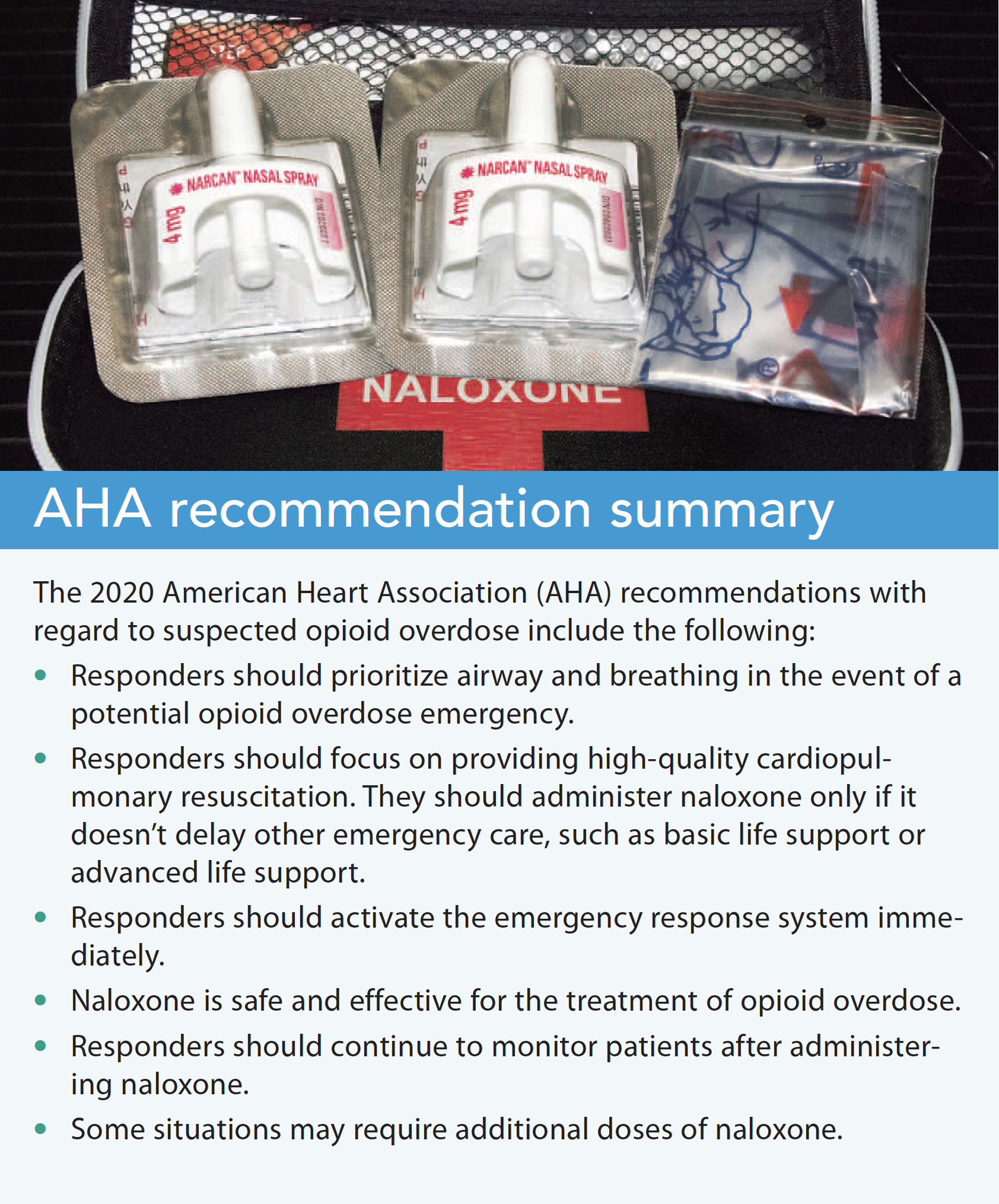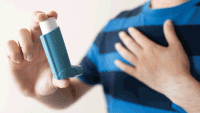2020 American Heart Association recommendation review
- Opioid-related overdoses and death in the United States continue to increase.
- American Heart Association (AHA) identified rescue medications, such as naloxone, as an important step in the chain of survival for patients in respiratory or cardiac arrest.
- Nurses in all settings should be aware of AHA recommendations as well as how to execute appropriate rescue steps based on patient scenario.
Over the past 10 years, opioid-related overdoses and death have steadily increased across the United States. The World Health Organization indicates that about half a million deaths are attributable to drug use globally, with about 70% specifically related to opioids. In 2018, synthetic opioids, specifically fentanyl, accounted for about two-thirds of opioid deaths. With this in mind, the American Heart Association (AHA) identified rescue medications, such as naloxone, as an important step in the chain of survival for patients in respiratory or cardiac arrest. The AHA also recognized that a rescue medication may not always be available and that bystanders at an event may not be trained or prepared to administer it. In addition, some may have difficulty identifying an opioid-related emergency if no obvious indication exists. In 2015, AHA included initial guidance on opioid-related overdose in 2015, with updates in the 2020 guidelines. (See AHA recommendation summary.)
Nurses in all settings should be aware of these recommendations as well as how to execute appropriate rescue steps based on patient scenario. In-hospital rescues may be necessary in cases where patients experience opioid toxicity because of overlapping therapies, high doses in those with relative opioid naivety, or therapeutic doses overlapping with additional self-administered opioids. Unintentional overdose also can occur in ambulatory clinics or offices, especially in procedural areas where opioids may be used. Nurses also may encounter an opioid toxicity event in the community or among friends, family, or peers. According to the Center for Disease Control and Prevention, over 46,000 overdose deaths involved opioids in 2018. That accounts for about two-thirds of the overdose deaths that year.
Physiology of an opioid overdose
Opioids interact with a number of neuroreceptors, but the interaction with µ-opioid receptors most significantly impacts respiratory effort. Excessive amounts of opioids decrease the respiratory drive, which leads to hypoventilation. This respiratory pattern doesn’t provide enough oxygen for the body, resulting in hypoperfusion. The decrease in ventilation and perfusion itself warrants an emergency, but it also can result in cardiac arrest from cardiac oxygen deprivation.
When assessing the patient, the responder may notice a decrease in level of consciousness and a decrease in respiratory rate, depth, and regulation. The patient may show signs of hypoxia, such as pallor, and may have difficulty maintaining their own airway if they can’t remain upright or alert. Once the patient has an ineffective or no respiratory pattern, their pulse may be weak or absent. Even with training, a layperson responding to an emergency may not be able to identify pulselessness appropriately, so the AHA recommends providing aid, especially in activating the emergency response system, immediately upon recognizing an emergent or potentially emergent situation.
2020 recommendations
For patients suspected to be in cardiac arrest, BLS and advanced life support (ALS) should take precedence over providing naloxone. The AHA doesn’t recommend naloxone as a standalone therapy in the event of respiratory or cardiac arrest. By continuing to support the cardiopulmonary system, the responder can increase the possibility of preserving valuable tissue through continued perfusion and reduce the risk for disability. Even providing compression-only CPR can help maintain circulation until additional help arrives. When naloxone is provided, CPR shouldn’t be delayed or obstructed.
Compared to the 2015 recommendations, the updated 2020 guidelines emphasize providing cardiopulmonary support over rescue drugs. This guidance reflects a better understanding of using rescue medications, especially in the community setting. In outpatient settings, according to AHA research, a lay rescuer who received training (especially hands-on training) was more likely to provide naloxone in an overdose situation, but the drug may not be readily available or appropriate, and providing CPR should not be delayed. In addition, overdoses frequently involve multiple substances. In 2016, almost 80% of synthetic opioid overdose deaths included an additional substance, including other drugs (illicit or prescription) or alcohol. With this in mind, rescuers should know that administering naloxone will only counteract the effects of the opioid and may not provide full relief or improvement.
Activate the emergency response system regardless of intervention. Early activation of the emergency response system is essential to address concerns other than overdose or if central nervous system symptoms persist, even after naloxone administration. AHA recommendations state that activating the emergency response system should coincide with initiating emergency treatment (CPR) whenever feasible.
In situations where a patient is primarily experiencing respiratory symptoms and an opioid overdose is suspected, naloxone administration is appropriate. Naloxone is safe and effective in the event of opioid overdose. Research indicates that naloxone administered before respiratory or cardiac arrest can help prevent patient deterioration. This finding supports including naloxone as part of the resuscitation pathway.
Rescuers must understand how to administer the medication appropriately. Naloxone is available in three formulations: injectable, auto-injectable, or intranasal prefilled cartridge. An injectable formula frequently is available in hospitals and some outpatient healthcare settings. Rescuers should follow facility administration orders and guidelines. In many out-of-hospital settings, especially nonhealthcare settings, the auto-injectable or nasal spray formulation may be more readily available. These formulations come packaged with instructions, and some include audible prompts to help guide a rescuer through administration.
Healthcare providers and emergency responders can administer naloxone. In some areas, naloxone can be provided to and administered by lay responders (friends, family members, and other community members). The increased availability of rescue medication in and out of hospital settings allows the medication to play a part in the chain of survival for patients with opioid toxicity. It also has increased training for opioid users, their support networks, and community members.
The benzodiazepine antagonist flumazenil shouldn’t be administered in cases where an individual is found with an undifferentiated overdose. The benefits of the medication don’t outweigh the risks associated with its administration. Instead, rescuers should provide supportive respiratory care.
If the patient responds positively to naloxone administration, rescuers should continue to observe the patient. After naloxone administration, AHA recommends continued supportive care. Naloxone is a fast-acting medication with a short half-life (about 30 to 45 minutes). Depending on the dose, not all of the opioids consumed will have metabolized and could still be available to neuroreceptors. In this case, the patient may experience additional opioid overdose symptoms, including respiratory depression. Alerting the emergency response system helps to ensure appropriate monitoring and supportive care in the out-of-hospital location and during transport to an acute facility.
After naloxone administration, rescuers may observe behavioral changes in the patient, including agitation. Responders should be prepared to provide safety measures for the patient and themselves.
Additional doses of naloxone may be required. Naloxone’s short half-life may require additional doses for full overdose recovery. This knowledge can help determine post-event patient care. Naloxone provided for community response frequently contain enough medication for two doses. Rescuers should be aware of this in case an additional dose is required.
Resuscitation education science
AHA resuscitation education recommendations highlight best practices and research related to the training and support of resuscitation learners. The AHA 2020 guidelines note that lay rescuers can receive training on appropriate resuscitation response for potential opioid overdose, including the use of naloxone. Nurses and other community responders should be aware of their local regulations and consider the potential availability of naloxone if responding in out-of-hospital settings.
Pediatric resuscitation
Similar to the adult guidelines, the AHA recommends the same steps when opioid overdose is suspected in an unresponsive pediatric patient. The AHA cites research that indicates no data specifically focused on pediatric patients exist. However, in 2018, over 3,500 individuals under the age of 24 died of opioid overdose in the United States. The AHA determined that the level of risk for harm as well as the trends of increasing overdose deaths make it reasonable to apply the adult algorithm to pediatric patients.
Future research
Opportunities exist to develop further evidence and research related to the specific role bystander training plays in naloxone administration and resuscitation success. After identifying a patient who may be experiencing an opioid overdose, beginning CPR presents limited risk and is preferred to spending valuable time seeking naloxone, especially if the medication may not be beneficial or available. With additional research, AHA will communicate guidance related to relative risk. To more clearly define a priority in resuscitation, additional research is needed into the impact of CPR and naloxone. For example, research should directly compare outcomes of CPR-only response with combination CPR and naloxone administration.
Respond appropriately
Including interventions for suspected opioid overdose in the 2020 AHA guidelines for CPR reflects trends in the United States showing increased frequency of opioid overdose and the role bystanders play in recognizing the condition and providing treatment. Nurses who stay current with AHA and other organization recommendations can respond appropriately when they’re in the hospital or in the community.
Amanda Murray is a clinical nurse specialist at Norton Healthcare in Louisville, Kentucky.
References
Algera MH, Kamp J, van der Schrier R, et al. Opioid-induced respiratory depression in humans: A review of pharmacokinetic–pharmacodynamic modelling of reversal. Br J Anaesth. 2019;122(6):e168-79. doi:10.1016/j.bja.2018.12.023
American Heart Association. Highlights of the 2020 AHA guidelines update for CPR and ECC. 2020. cpr.heart.org/en/resuscitation-science/cpr-and-ecc-guidelines
Centers for Disease Control and Prevention. Drug overdose: Other drugs. November 18, 2021. cdc.gov/drugoverdose/data/otherdrugs.html
Cheng A, Magid DJ, Auerbach M, et al. Part 6: Resuscitation education science: 2020 American Heart Association guidelines for cardiopulmonary resuscitation and emergency cardiovascular care. Circulation. 2020;142(suppl 2):S551-79. doi:10.1161/CIR.0000000000000903
Lavonas EJ, Drennan IR, Gabrielli A, et al. Part 10: Special circumstances of resuscitation: 2015 American Heart Association guidelines update for cardiopulmonary resuscitation and emergency cardiovascular care. Circulation. 2015;132 (18 suppl 2):S501-18. doi:10.1161/CIR.0000000000000264
National Institute on Drug Abuse. Naloxone. January 2022. nida.nih.gov/publications/drugfacts/naloxone
Olasveengen TM, Mancini ME, Perkins GD, et al. Adult basic life support: 2020 international consensus on cardiopulmonary resuscitation and emergency cardiovascular care science with treatment recommendation. Circulation. 2020;142(suppl 1):S41-91. doi:10.1161/CIR.0000000000000892
Panchal AR, Bartos JA, Cabañas JG, et al. Part 3: Adult basic and advanced life support: 2020 American Heart Association guidelines for cardiopulmonary resuscitation and emergency cardiovascular care. Circulation. 2020;142(16 suppl 2):S366-468. doi:10.1161/CIR.0000000000000916
Topjian AA, Raymond TT, Atkins D, et al. Part 4: Pediatric basic and advanced life support: 2020 American Heart Association guidelines for cardiopulmonary resuscitation and emergency cardiovascular care. Circulation. 2020;142(16 suppl 2):S469-523. doi:10.1161/CIR.0000000000000901
Wilson N, Kariisa M, Seth P, Smith H, Davis NL. Drug and opioid-involved overdose deaths—United States, 2017-2018. Morb Mortal Wkly Rep. March 20, 2020. cdc.gov/mmwr/volumes/69/wr/pdfs/mm6911a4-H.pdf
World Health Organization. Opioid overdose. August 4, 2021. who.int/news-room/fact-sheets/detail/opioid-overdose
American Nurse Journal. 2022; 27 (11). Doi: 10.51256/ANJ112220



















